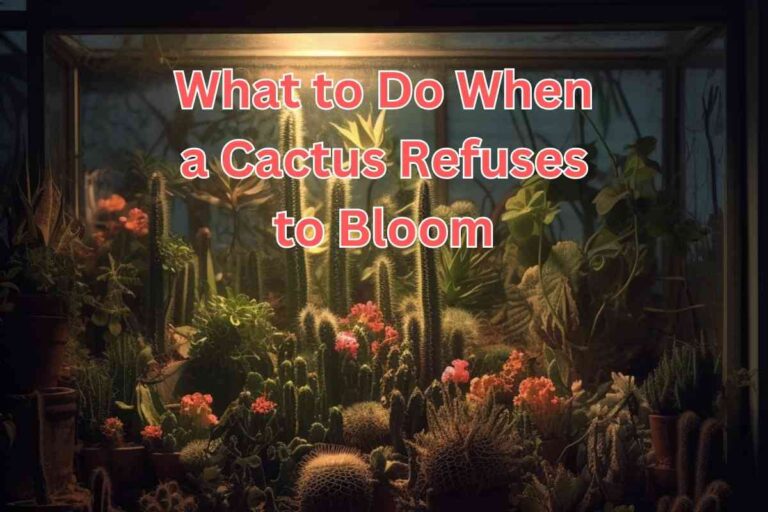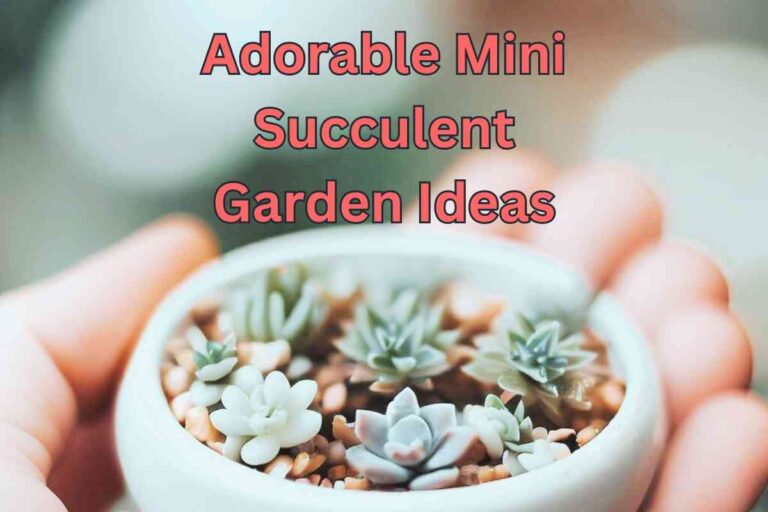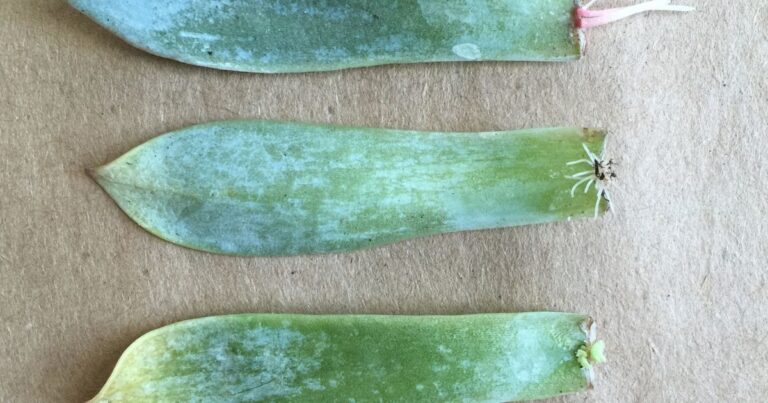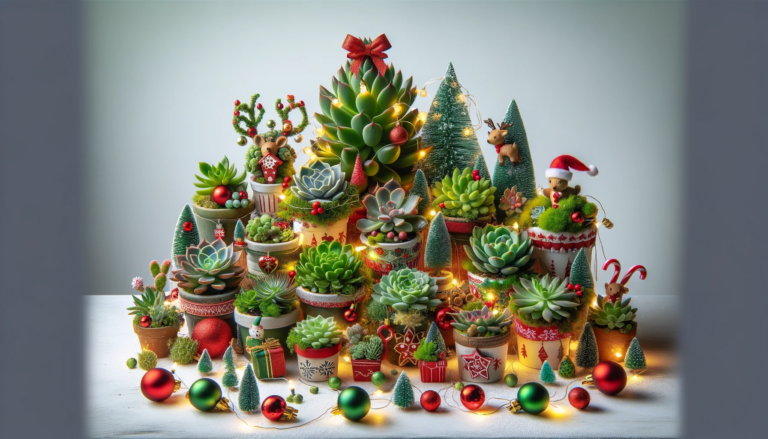13 Types of Sedum Succulents: Best Plant Varieties Guide
Key Takeaways
- Sedum succulents are a diverse group of plants known for their beauty, resilience, and low maintenance requirements.
- Understanding Sedum Succulents is crucial for growing these plants successfully.
- Popular Types of Sedum Succulents include Sedum morganianum, Sedum rubrotinctum, and Sedum spectabile.
Sedum succulents are a diverse group of plants that are known for their beauty, resilience, and low maintenance requirements. These plants are part of the Crassulaceae family and are commonly referred to as stonecrop.
Sedum succulents are native to many parts of the world, including North America, Europe, and Asia. They come in various shapes, sizes, and colors, making them a popular choice for gardeners and landscapers alike.
Understanding Sedum Succulents is crucial if you want to grow these plants successfully. Sedum succulents are known for their ability to store water in their leaves, making them drought-tolerant and easy to care for.
They thrive in well-draining soil and full sun, but some species can also tolerate partial shade. Growing Conditions for Sedum Succulents can vary depending on the type of plant, but most species prefer dry, rocky, or sandy soil.
Understanding Sedum Succulents
Sedum succulents are a diverse genus of perennial succulent plants that belong to the Stonecrop family, also known as the Crassulaceae family. These plants are known for their fleshy, water-storing leaves, which make them drought-resistant and easy to care for. In this section, we will explore the characteristics of Sedum succulents and what makes them unique.
One of the defining features of Sedum succulents is their ability to thrive in a variety of growing conditions. They are adaptable and can grow in full sun or partial shade, making them a popular choice for gardens and landscapes. Sedum succulents come in a range of shapes, sizes, and colors, from small groundcovers to tall, upright plants. Some popular species of Sedum include Sedum spurium, Sedum reflexum, and Sedum acre.
Sedum succulents are also known for their hardiness and resilience. They can withstand extreme temperatures, from freezing winters to scorching summers, making them ideal for gardens in a wide range of climates. These plants are also low-maintenance and require minimal watering and fertilization.
Another interesting feature of Sedum succulents is their ability to propagate easily. Many species of Sedum can be propagated from stem or leaf cuttings, making them an excellent choice for gardeners who want to expand their collection of succulents. Some species of Sedum can also be grown from seed.
When it comes to caring for Sedum succulents, there are a few things to keep in mind. These plants prefer well-draining soil and should be watered sparingly, as overwatering can lead to root rot. Sedum succulents also benefit from occasional fertilization with a balanced, low-nitrogen fertilizer.
In summary, Sedum succulents are a versatile and easy-to-care-for genus of succulent plants that are well-suited to a variety of growing conditions. They are hardy, resilient, and come in a range of shapes and colors. Whether you are a seasoned gardener or just starting out, Sedum succulents are an excellent choice for adding beauty and interest to your garden or landscape.
Growing Conditions for Sedum Succulents
When it comes to growing Sedum succulents, there are a few important factors to consider. These plants are generally easy to care for and can thrive in a variety of conditions, but there are a few things you should keep in mind to ensure they grow healthy and strong.
Light Requirements
Sedum succulents generally prefer full sun or direct sunlight for at least 6 hours per day. However, some varieties can also tolerate partial shade. If you’re unsure about how much light your Sedum needs, check the specific care instructions for your particular variety.
Soil Requirements
Sedum succulents prefer well-draining soil with good drainage. Poor soil or soil that retains too much moisture can lead to root rot and other issues. Sandy soil is a good option for Sedum succulents, as it allows for good drainage. If you’re planting your Sedum in a pot, make sure it has drainage holes to prevent water from pooling at the bottom.
| Soil Type | Suitability |
|---|---|
| Well-drained soil | Ideal |
| Poor soil | Not ideal |
| Sandy soil | Ideal |
| Clay soil | Not ideal |
Water Requirements
Sedum succulents are drought-tolerant and don’t require much water. In fact, overwatering can be a problem for these plants, as it can lead to root rot. Water your Sedum only when the soil is completely dry. During the growing season, you may need to water your Sedum once a week or less. In the winter, you can cut back on watering even more.
| Watering | Frequency |
|---|---|
| Summer | Once a week or less |
| Winter | Cut back on watering |
Overall, Sedum succulents are easy to care for and can thrive in a variety of conditions. By providing them with the right growing conditions, you can ensure that they grow healthy and strong. Remember to always check the specific care instructions for your particular variety to ensure you’re providing the best care possible.
Popular Types of Sedum Succulents
If you’re looking for a low-maintenance, drought-tolerant plant that can add texture and color to your garden, then sedum succulents are a great option. Here are some of the most popular types of sedum succulents you should consider planting:
Upright Sedum
Upright sedum varieties are known for their tall, sturdy stems and upright growth habit. They can reach up to 2 feet in height and are great for adding height and structure to your garden. Some popular upright sedum varieties include:
| Sedum Variety | Common Name | Description |
|---|---|---|
| Sedum ‘Autumn Joy’ | Autumn Joy Stonecrop | A popular variety with green leaves that turn reddish-bronze in fall. Pink flowers bloom in late summer to early fall. |
| Sedum ‘Matrona’ | Matrona Stonecrop | A striking variety with blue-green leaves and pink flowers that bloom in late summer. |
| Sedum ‘Brilliant’ | Brilliant Stonecrop | A compact variety with bright pink flowers that bloom in late summer. |
Low-Growing Sedum
Low-growing sedum varieties are great for ground cover and can spread quickly to fill in empty spaces in your garden. They typically reach a height of 6 inches or less and have a dense, mat-forming growth habit. Some popular low-growing sedum varieties include:
| Sedum Variety | Common Name | Description |
|---|---|---|
| Sedum ‘Angelina’ | Angelina Stonecrop | A low-growing variety with yellow-green foliage that turns orange in fall. |
| Sedum ‘Dragon’s Blood’ | Dragon’s Blood Stonecrop | A colorful variety with red-tinted foliage and pink flowers that bloom in summer. |
| Sedum spurium | Two-Row Stonecrop | A hardy variety with small, green leaves and pink flowers that bloom in summer. |
Mat-Forming Sedum
Mat-forming sedum varieties are great for covering large areas and can be used as ground cover or in rock gardens. They typically have a low, spreading growth habit and can tolerate drought and poor soil conditions. Some popular mat-forming sedum varieties include:
| Sedum Variety | Common Name | Description |
|---|---|---|
| Sedum album | White Stonecrop | A low-growing variety with small, white flowers that bloom in summer. |
| Sedum kamtschaticum | Russian Stonecrop | A hardy variety with yellow flowers that bloom in summer. |
| Sedum reflexum | Blue Spruce Stonecrop | A unique variety with blue-green foliage that resembles a miniature spruce tree. |
Overall, sedum succulents are a versatile and easy-to-grow plant that can add interest and beauty to any garden. Whether you’re looking for an upright, low-growing, or mat-forming variety, there’s a sedum succulent that’s perfect for your needs.
Notable Sedum Species
If you’re looking for a low-maintenance and drought-tolerant plant for your garden or indoor collection, Sedum is an excellent choice. With over 400 species to choose from, there’s a Sedum for every climate and preference. Here are some notable Sedum species to consider:
Sedum Spurium
Sedum spurium, also known as Two-Row Stonecrop, is a low-growing Sedum that spreads rapidly and forms a dense mat of foliage. It’s a hardy plant that can tolerate a wide range of growing conditions, making it an excellent choice for ground cover. The plant produces clusters of pink or red flowers in the summer, adding a pop of color to your garden.
Sedum Rupestre
Sedum rupestre, also known as Reflexed Stonecrop, is a hardy Sedum that can survive in poor soil conditions. It’s a low-growing plant that forms a dense mat of foliage, making it an excellent choice for ground cover. The plant produces yellow flowers in the summer, adding a bright splash of color to your garden.
Sedum Adolphii
Sedum adolphii, also known as Golden Sedum, is a popular Sedum for indoor collections. It’s a low-growing plant with succulent leaves that turn golden yellow in bright sunlight. The plant produces small yellow flowers in the summer, adding a touch of color to your indoor garden.
Sedum Morganianum
Sedum morganianum, also known as Burro’s Tail or Donkey’s Tail, is a trailing Sedum with long, delicate stems covered in small, plump leaves. The plant is popular for its unique appearance and is often grown in hanging baskets. It produces small pink or red flowers in the summer.
Sedum Rubrotinctum
Sedum rubrotinctum, also known as Jelly Bean Sedum, is a small Sedum with plump, jelly bean-shaped leaves that turn red in bright sunlight. The plant produces small yellow flowers in the summer, adding a touch of color to your indoor collection. It’s a popular choice for succulent gardens and arrangements.
Sedum Dasyphyllum
Sedum dasyphyllum, also known as Corsican Stonecrop, is a low-growing Sedum with tiny, round leaves that form a dense mat of foliage. The plant produces small white or pink flowers in the summer, adding a delicate touch of color to your garden. It’s a hardy plant that can tolerate a wide range of growing conditions.
Sedum Kamtschaticum
Sedum kamtschaticum, also known as Russian Stonecrop, is a hardy Sedum that can survive in poor soil conditions. It’s a low-growing plant that forms a dense mat of foliage, making it an excellent choice for ground cover. The plant produces yellow flowers in the summer, adding a bright splash of color to your garden.
Sedum Acre
Sedum acre, also known as Goldmoss Stonecrop, is a low-growing Sedum that forms a dense mat of foliage. The plant produces clusters of yellow flowers in the summer, adding a bright pop of color to your garden. It’s a hardy plant that can tolerate a wide range of growing conditions.
Sedum Album
Sedum album, also known as White Stonecrop, is a low-growing Sedum with small, white flowers that bloom in the summer. The plant forms a dense mat of foliage and is often used as ground cover. It’s a hardy plant that can tolerate a wide range of growing conditions.
Sedum Spectabile
Sedum spectabile, also known as Showy Stonecrop, is a tall Sedum that produces clusters of pink or red flowers in the late summer or early fall. The plant is popular for its late-season blooms and is often used in perennial borders or as a focal point in a garden.
Sedum Telephium
Sedum telephium, also known as Live-Forever or Orpine, is a tall Sedum with clusters of pink or red flowers that bloom in the late summer or early fall. The plant is popular for its late-season blooms and is often used in perennial borders or as a focal point in a garden.
Sedum Cauticola
Sedum cauticola, also known as Coastal Stonecrop, is a low-growing Sedum with pink or purple flowers that bloom in the summer. The plant forms a dense mat of foliage and is often used as ground cover. It’s a hardy plant that can tolerate a wide range of growing conditions.
Sedum Ewersii
Sedum ewersii, also known as Ewer’s Stonecrop, is a low-growing Sedum with clusters of pink or purple flowers that bloom in the summer. The plant forms
Caring for Sedum Succulents
Sedum succulents are easy to care for and can thrive in a variety of conditions. Here are some tips to help you grow and care for your Sedum succulents.
Watering
Sedum succulents are drought-tolerant, which means they can survive long periods without water. However, they still need some moisture to thrive. When watering your Sedum succulents, make sure to water deeply and then allow the soil to dry out completely before watering again. Overwatering can lead to root rot, which can be fatal to your plants.
| Watering Frequency | Amount of Water |
|---|---|
| Once a week | 1/4 cup |
| Once every 2 weeks | 1/2 cup |
| Once a month | 1 cup |
Pruning
Sedum succulents do not require much pruning, but it can help keep them healthy and looking their best. Prune any dead or damaged leaves or stems as soon as you notice them. This will prevent any diseases from spreading to the rest of the plant. You can also prune your Sedum succulents to control their size or shape. Use sharp, clean scissors or pruning shears to avoid damaging the plant.
Propagation
Propagation is an easy way to grow new Sedum succulent plants. You can propagate Sedum succulents using stem cuttings or by dividing the plant. To propagate using stem cuttings, cut a healthy stem from the parent plant and let it dry out for a day or two. Then, plant the stem in a well-draining soil mix and water lightly. In a few weeks, you should see new roots and growth.
To divide a Sedum succulent, gently remove the plant from its pot and separate the roots into two or more sections. Each section should have some roots and leaves. Plant each section in its own pot with fresh soil mix and water lightly.
Overall, Sedum succulents are low-maintenance plants that are perfect for beginners and experienced gardeners alike. With proper care and attention, your Sedum succulents will thrive and bring beauty to your home or garden.
Seasonal Changes and Flowering
Sedum succulents are known for their hardiness and ability to survive in a variety of conditions. They are also popular for their beautiful flowers that bloom at different times of the year. Understanding the seasonal changes and flowering patterns of different types of sedum succulents can help you plan and care for your garden effectively.
Spring
In early spring, most sedum succulents start to emerge from their winter dormancy. This is the time when you will see new growth and buds forming. Some of the popular sedum varieties that bloom in early spring include Sedum album, Sedum cauticola, and Sedum spurium. These plants are known for their small, delicate flowers that come in shades of pink, white, and purple.
Summer
Summer is the most active growing season for sedum succulents. During these months, you will see the plants grow rapidly and produce large, showy flowers. Late summer is the peak flowering season for most sedum varieties. Some of the popular sedum varieties that bloom in summer include Sedum telephium, Sedum spectabile, and Sedum ‘Autumn Joy’. These plants are known for their large, flat flower heads that come in shades of pink, red, and white.
Fall
In fall, sedum succulents start to slow down their growth and prepare for winter. This is the time when you will see the plants start to change color, with some varieties turning shades of yellow, orange, and red. Some of the popular sedum varieties that bloom in fall include Sedum ‘Matrona’, Sedum ‘Bertram Anderson’, and Sedum ‘Purple Emperor’. These plants are known for their deep, rich colors and their ability to provide winter interest in the garden.
Winter
In winter, most sedum succulents go dormant and lose their leaves. However, some varieties are known for their ability to provide winter interest in the garden. These plants have interesting seed heads or stems that add texture and structure to the winter landscape. Some of the popular sedum varieties that provide winter interest include Sedum ‘Brilliant’, Sedum ‘Autumn Fire’, and Sedum ‘Frosty Morn’.
| Sedum Variety | Flowering Time | Flower Color |
|---|---|---|
| Sedum album | Early spring | Pink, white, purple |
| Sedum telephium | Late summer | Pink, red, white |
| Sedum ‘Matrona’ | Fall | Deep pink |
| Sedum ‘Brilliant’ | Winter | Pink |
| Sedum ‘Autumn Joy’ | Late summer | Pink, red |
| Sedum ‘Frosty Morn’ | Winter | White |
Understanding the seasonal changes and flowering patterns of different types of sedum succulents can help you plan and care for your garden effectively. Whether you want to create a colorful spring garden or provide winter interest in your landscape, there is a sedum variety that can meet your needs.
Sedum Succulents in Landscaping
Sedum succulents are a versatile group of plants that can be used in a variety of landscaping applications. Here are some ways you can incorporate them into your garden:
Rock Gardens
Sedum succulents are a popular choice for rock gardens due to their ability to thrive in dry, rocky environments. Their low-growing habit and wide range of colors and textures make them a great choice for adding interest to a rock garden. Some popular varieties for rock gardens include Sedum spurium ‘Dragon’s Blood’, Sedum reflexum ‘Blue Spruce’, and Sedum ‘Angelina’.
Green Roofs
Sedum succulents are also commonly used in green roof installations due to their drought-tolerant nature and ability to thrive in shallow soil. They are often used in combination with other low-growing plants to create a low-maintenance, evergreen ground cover. Some popular varieties for green roofs include Sedum acre, Sedum album, and Sedum rupestre.
| Sedum Variety | Height | Spread | Soil Requirements |
|---|---|---|---|
| Sedum acre | 2-3 inches | 6-8 inches | Well-draining |
| Sedum album | 2-4 inches | 6-12 inches | Well-draining |
| Sedum rupestre | 4-6 inches | 12-18 inches | Well-draining |
Border Plants
Sedum succulents can also be used as border plants to add interest and texture to garden beds. Their low-growing habit and drought-tolerant nature make them a great choice for edging paths or garden beds. Some popular varieties for border plants include Sedum ‘Autumn Joy’, Sedum ‘Matrona’, and Sedum ‘Vera Jameson’.
When selecting sedum succulents for your landscaping project, it’s important to consider the specific needs of the variety you’re interested in. Some sedums prefer well-draining soil, while others can tolerate more moisture. Additionally, some varieties may be more suited to certain growing conditions than others.
Overall, Sedum succulents are a great choice for anyone looking to add low-maintenance, drought-tolerant plants to their landscaping. With their wide range of colors, textures, and growing habits, there’s sure to be a variety that will work well in your garden.
Visual Characteristics of Sedum Succulents
Sedum succulents are known for their unique and beautiful appearance. They have a variety of visual characteristics that make them stand out from other succulent plants.
Leaves
Sedum succulents have fleshy, succulent leaves that are often bright green, blue-green, or even purple in color. Some species have needle-like foliage, while others have small, round leaves. The lower leaves of Sedum succulents are often spaced out along the stem, giving the plant a rosette-like appearance.
Flowers
Sedum succulents produce a wide variety of flowers. Some species have small white flowers, while others have small, star-shaped flowers. Many Sedum succulents have flower heads that are made up of many small flowers. The color of the flowers can range from yellow to pink, and some species even have blue or purple flowers.
To better understand the different types of Sedum succulent flowers, refer to the following table:
| Flower Color | Flower Shape | Sedum Species |
|---|---|---|
| Yellow | Small, star-shaped | Sedum acre |
| Pink | Small, round | Sedum dasyphyllum |
| Pink | Small, star-shaped | Sedum spurium |
| Yellow | Small, round | Sedum kamtschaticum |
| Yellow | Small, star-shaped | Sedum album |
| Pink | Flower heads made up of many small flowers | Sedum spectabile |
| Yellow | Flower heads made up of many small flowers | Sedum telephium |
In conclusion, Sedum succulents have a wide variety of visual characteristics that make them unique and beautiful. From their fleshy, succulent leaves to their small, colorful flowers, Sedum succulents are a great addition to any succulent collection.
Choosing the Right Sedum for You
If you’re looking for a low-maintenance and drought-tolerant plant that can thrive in a sunny spot, Sedums are a great addition to your collection. With so many different varieties to choose from, it can be overwhelming to know which one to pick. Here are some popular choices to help you decide.
Golden Sedum
Golden Sedum (Sedum adolphii) is a bright and beautiful plant that can add a pop of color to any space. It prefers bright light and can thrive in a sunny spot. This tender succulent is a good choice for those who are looking for a low-maintenance plant that doesn’t require a lot of attention. Its small shrub-like appearance makes it a great choice for indoor planting.
Upright Varieties
If you’re looking for a Sedum that grows tall and upright, then the ‘Autumn Joy’ (Sedum spectabile) or the ‘Matrona’ (Sedum telephium) are great choices. These Sedums can grow up to 2 feet tall and are perfect for adding height to your garden. They prefer a sunny spot and can tolerate drought conditions, making them a great choice for low-maintenance gardeners.
Low Maintenance
Sedums are known for their low-maintenance nature, but some varieties are even easier to care for than others. The ‘Dragon’s Blood’ (Sedum spurium) is a great choice for those who want a Sedum that requires little attention. This Sedum can grow in full sun or partial shade and can tolerate drought conditions. It’s also a great choice for ground cover.
Table
| Sedum Variety | Best For | Care Level |
|---|---|---|
| Golden Sedum | Indoor planting, small shrub | Low |
| ‘Autumn Joy’ | Adding height to garden | Low |
| ‘Matrona’ | Adding height to garden | Low |
| ‘Dragon’s Blood’ | Ground cover | Low |
In conclusion, Sedums are a great choice for those who want a low-maintenance and drought-tolerant plant. With so many different varieties to choose from, it’s important to consider your needs and preferences before making a decision. Whether you’re looking for a pop of color, height, or ground cover, there’s a Sedum variety that’s right for you.
Frequently Asked Questions
What are some popular varieties of sedum succulents?
Some popular varieties of sedum succulents include Sedum rubrotinctum, Sedum morganianum, Sedum adolphii, and Sedum nussbaumerianum. These varieties are known for their unique colors, shapes, and textures.
Are there any tall sedum succulent varieties?
Yes, there are tall sedum succulent varieties, such as Sedum spectabile and Sedum telephium. These varieties can grow up to two feet tall and are known for their showy flowers.
How many types of sedum succulents are there?
There are over 400 different types of sedum succulents. These varieties can range in size, shape, and color.
What is the difference between a succulent and a sedum?
Succulents are a type of plant that store water in their leaves, stems, or roots. Sedums are a specific type of succulent that belong to the Crassulaceae family. While all sedums are succulents, not all succulents are sedums.
Are sedum succulents toxic to cats?
According to the ASPCA, sedum succulents are not toxic to cats. However, it is always important to monitor your pets when introducing new plants to your home.
What is the difference between sedum and stonecrop?
Sedum and stonecrop are often used interchangeably to refer to the same plant. However, some sources differentiate between the two by noting that stonecrop refers to low-growing sedums, while sedum refers to taller varieties.
Some popular varieties of sedum succulents include Sedum rubrotinctum, Sedum morganianum, Sedum adolphii, and Sedum nussbaumerianum. These varieties are known for their unique colors, shapes, and textures.
“}},{“@type”:”Question”,”name”:”Are there any tall sedum succulent varieties?”,”acceptedAnswer”:{“@type”:”Answer”,”text”:”
Yes, there are tall sedum succulent varieties, such as Sedum spectabile and Sedum telephium. These varieties can grow up to two feet tall and are known for their showy flowers.
“}},{“@type”:”Question”,”name”:”How many types of sedum succulents are there?”,”acceptedAnswer”:{“@type”:”Answer”,”text”:”
There are over 400 different types of sedum succulents. These varieties can range in size, shape, and color.
“}},{“@type”:”Question”,”name”:”What is the difference between a succulent and a sedum?”,”acceptedAnswer”:{“@type”:”Answer”,”text”:”
Succulents are a type of plant that store water in their leaves, stems, or roots. Sedums are a specific type of succulent that belong to the Crassulaceae family. While all sedums are succulents, not all succulents are sedums.
“}},{“@type”:”Question”,”name”:”Are sedum succulents toxic to cats?”,”acceptedAnswer”:{“@type”:”Answer”,”text”:”
According to the ASPCA, sedum succulents are not toxic to cats. However, it is always important to monitor your pets when introducing new plants to your home.
“}},{“@type”:”Question”,”name”:”What is the difference between sedum and stonecrop?”,”acceptedAnswer”:{“@type”:”Answer”,”text”:”
Sedum and stonecrop are often used interchangeably to refer to the same plant. However, some sources differentiate between the two by noting that stonecrop refers to low-growing sedums, while sedum refers to taller varieties.
“}}]}





